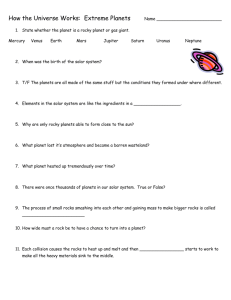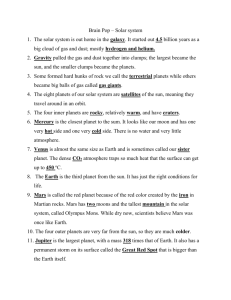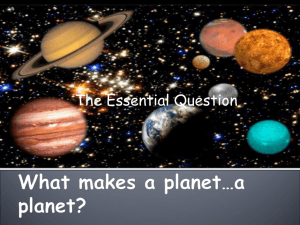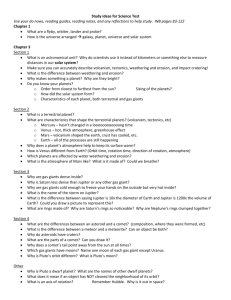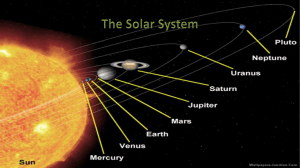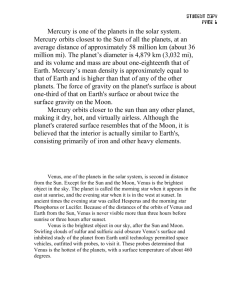Video Review - Sierra College Astronomy Home Page
advertisement
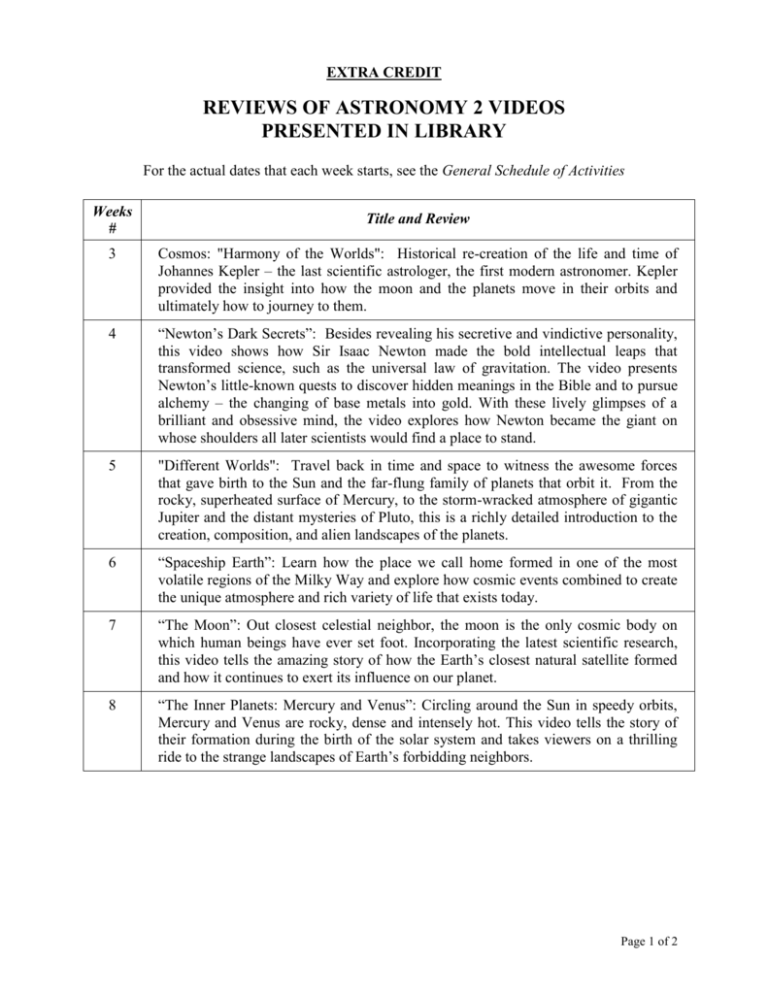
EXTRA CREDIT REVIEWS OF ASTRONOMY 2 VIDEOS PRESENTED IN LIBRARY For the actual dates that each week starts, see the General Schedule of Activities Weeks # Title and Review 3 Cosmos: "Harmony of the Worlds": Historical re-creation of the life and time of Johannes Kepler – the last scientific astrologer, the first modern astronomer. Kepler provided the insight into how the moon and the planets move in their orbits and ultimately how to journey to them. 4 “Newton’s Dark Secrets”: Besides revealing his secretive and vindictive personality, this video shows how Sir Isaac Newton made the bold intellectual leaps that transformed science, such as the universal law of gravitation. The video presents Newton’s little-known quests to discover hidden meanings in the Bible and to pursue alchemy – the changing of base metals into gold. With these lively glimpses of a brilliant and obsessive mind, the video explores how Newton became the giant on whose shoulders all later scientists would find a place to stand. 5 "Different Worlds": Travel back in time and space to witness the awesome forces that gave birth to the Sun and the far-flung family of planets that orbit it. From the rocky, superheated surface of Mercury, to the storm-wracked atmosphere of gigantic Jupiter and the distant mysteries of Pluto, this is a richly detailed introduction to the creation, composition, and alien landscapes of the planets. 6 “Spaceship Earth”: Learn how the place we call home formed in one of the most volatile regions of the Milky Way and explore how cosmic events combined to create the unique atmosphere and rich variety of life that exists today. 7 “The Moon”: Out closest celestial neighbor, the moon is the only cosmic body on which human beings have ever set foot. Incorporating the latest scientific research, this video tells the amazing story of how the Earth’s closest natural satellite formed and how it continues to exert its influence on our planet. 8 “The Inner Planets: Mercury and Venus”: Circling around the Sun in speedy orbits, Mercury and Venus are rocky, dense and intensely hot. This video tells the story of their formation during the birth of the solar system and takes viewers on a thrilling ride to the strange landscapes of Earth’s forbidding neighbors. Page 1 of 2 EXTRA CREDIT REVIEWS OF ASTRONOMY 2 VIDEOS PRESENTED IN LIBRARY For the actual dates that each week starts, see the General Schedule of Activities 9 “Mars: The Red Planet”: Mars may make the future of humanity. Using data collected from probes and robotic rovers, this video takes viewers to the planet’s surface to shoe what life would be like for a human settlement, and speculates what kind of like forms could evolve in its unique atmosphere. 10 "Atmosphere": Atmospheres make weather. This can result in alien weather reports that seem as if they're taken right out of a science fiction film. The local forecast for this program: torrential sulfuric rain and metallic snow on Venus, global dust storms raging across Mars, and centuries-long Earth-sized cyclones circling Jupiter. It's an eye-opening exploration of otherworldly weather that reveals the surprising variety and force of atmospheric activity throughout the solar system. 11 “Jupiter: The Giant Planet”: Two and half times the size of all the other planets combined and half the billion miles from Earth, Jupiter is a colossal riddle whose remote distance and cloudy covering have made it difficult to study. Explore Jupiter and journey into immense storms that whirl around the planet’s surface. 12 “Saturn: Lord of the Rings”: Famous for its striking ring formations, Saturn is perhaps the most beautiful planet in planet in the solar system. Explore the unusual system of moons and rings that surround this stunning celestial body. 13 “The Outer Planets”: At the edge of the Solar System, we find the ice-gas giants of Uranus and Neptune and the tiny ex-planet Pluto. This video explores the demise of Pluto as a planet and its importance as a object in our solar system. We then turn to Uranus and Neptune which have rings and many icy satellites surrounding them. 14 “The End of the Earth: Deep Space Threats to our Planet”: Scars on the planet’s surface and in its fossil record chillingly illustrate the threat posed by meteorites, comets, and asteroids that routinely collided with the Earth. Explore the harrowing results that such an impact could have on the environment, and discover the new technologies scientists are developing to protect the planet from these perils. 15 "Secrets of the Sun": Take a guided tour to the surface of Earth’s life-giving star through computer-generated graphics that re-create the solar flares and storms that rage on its turbulent surface. Witness the sun’s birth at the dawn of our solar system and its death billions of years in the future. Page 2 of 2



